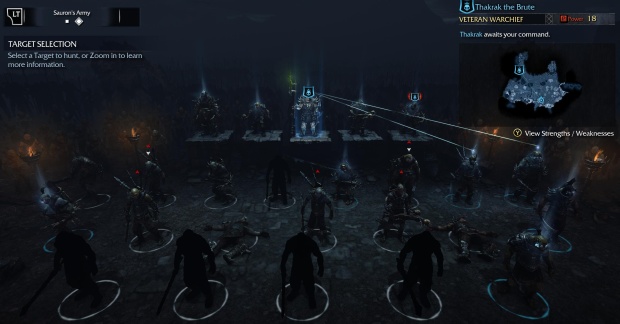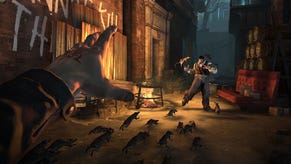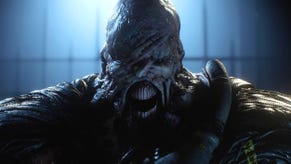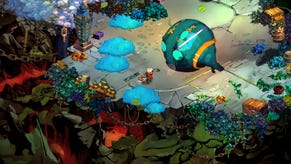Wot I Think Now I've Finished Shadow Of Mordor
Orcward Love
Now I've played for a large proportion of the last five days, with the main storyline completed, and a worrying number of the collectibles and side quests ticked off, I feel far more prepared to give a more definitive statement on Middle-Earth: Shadow Of Mordor: I love it.
When I wrote my Wot I Think So Far of the game last week, I already knew it was great. Now I know it’s brilliant.
The game makes all its big mistakes (and they’re very big mistakes) in the first hour. After that, it does something few games ever do: it gets continually better the further into it you get. And in order to say why, I’m going to talk about systems and unlocks that aren’t revealed until halfway through the game. If you want such things to be surprises, take the advice of my previous coverage and get hold of this action-brawler. If you want some more convincing, read on.
A lot have compared Shadow Of Mordor to Batman: Arkham City, or the Assassin’s Creed series. And with good reason. The game owes them vast amounts, cribbing giant chunks of each. But it’s to neither game I find myself comparing it upon completion. To me, it feels like the unofficial follow-up to the woefully under-rated and doom-ridden Kingdoms Of Amalur: Reckoning. And that’s high praise.
Shadow Of Mordor finds that same midpoint between the noble sincerity of a traditional RPG, and the bubblegum frivolity of a third-person action game. A straight-faced storyline draws quite a bold bridge between the events of The Hobbit and The Lord Of The Rings, dark tales of the rise of Sauron, further consequences of the creation of those pesky rings, and vengeance for slaughtered families. But at the same time, you rush around chopping the heads off thousands of orcs in spectacular slow-motion special moves. And ride on the backs of giant beasts, blow up campfires, and meddle in the grunted violent world of orc politics.
It’s this last part I want to celebrate most, but before I get there, I want to talk a bit more about the combat. This, like everything else, improves as you go along. Unlocking more abilities doesn’t make the combat simpler, nor indeed does the game make itself more difficult. It does something so damned rare: it becomes more interesting. The greater your arsenal of tricks and moves, the more intricate and complex fighting becomes. Instead of the game just throwing far harder enemies at you to make you feel constantly under-classed (one of my number one gaming frustrations), here it allows you to be more capable when faced with larger groups. Where once your only option was to run away, now you can cope, executing hit-streaks that unlock spectacular finishing moves, and then figuring how to string these together to become a whirling master of death, despite twenty or thirty orcs trying to attack you at once. And when those groups contain two or three Captains, the super-tough orc leaders, combat becomes like a wonderful dance. Perhaps no more than many of the games from which it borrows, it’s important to add, but still it feels wonderful.
And best of all, I worked out my own techniques within a huge array, much of which I didn’t use. I never explored the throwing knives, nor the wraith bursts, both of which could be elaborated. My preference was taking out a good number with arrows, then dropping in from stealth, and getting busy with my sword. Once I’d specced up to be able to unleash double-big moves with only a five-hit streak, I was a killing machine.
Let’s explore that Nemesis system further – I only touched on it before. There are two large maps that make up the game, the second reached, appropriately, midway through the main storyline. Each map has its own unique orc hierarchy, from ordinary grunts, to various ranks of Captains, to the top spots of the five Warchiefs. As you take out Captains, other orcs are promoted to take their place, lower ranking Captains stepping closer to the Warchief spot, and some becoming bodyguards for a particular Chief. And it’s within this system that you so satisfyingly meddle. Because by the halfway point of the game, you gain an ability to convert orcs to your side - branding.
This is done in various ways, all of which eventually involve your placing a hand over an orc’s face, and warping his mind to your wraith-passenger’s will. From stealth is the fastest way, and perhaps the most satisfying. Sneaking up behind a patrol of orcs, marching through a valley, and converting them one by one from back to front, is great stuff. Their eyes glow blue, and their faces bear your spectral handprint. You can make your way through entire strongholds, branding dozens of orcs, and then when you fancy it, activate the lot of them to fight for you – basically, start a little civil war.
But it gets far more interesting when you start applying this to Captains. Branding them isn’t so easy. They’ll prevent a simple sneaky face-grab, and need to be weakened first. That tends to involve quite a hefty fight, and usually one taking advantage of any strengths or weaknesses you might have learned about them. And even when they’re weak, you’ve got to make sure enough of their buddies are dispatched or far away, to have enough time to do a branding move without getting interrupted. However, brand them, and suddenly you’ve got orcs with influence on your side.
Branded Captains can be instructed to do your bidding. You can tell them to kill another Captain who you might find particularly annoying/threatening. Or you can set them onto a trial to become a Warchief’s bodyguard. Once they’re a bodyguard, you could then have them launch a coup against that leader. Each of these creates yet another side quest on the game map, alongside the dozens and dozens that are placed there by the game. Becoming a bodyguard might involve surviving a trial, or performing well in a hunt, which you can influence from the sidelines, or even by throwing yourself into the fight.
A Warchief killed by a bodyguard on your side is replaced by one of your own, meaning you have influence in the highest places. Or you can even try branding an existing Warchief, which again launches a sidequest – usually the hardest of all, and as a consequence, the most fun. Have all ten Chiefs (five from each map) on your side, and… well, not enough changes beyond the points gained from achieving the goal. But you will notice as you plod about the lands far more groups of orcs already on your side, influenced by their leaders.
I became utterly engrossed in these politics. I remember at one point seeing one of my Warchiefs get killed in a battle, opening up a spot on the rostrum. Not wanting it to get filled by someone I didn’t control, I immediately began looking through the Captains on my side, working out who I thought would be suitable, and tracking him down to take the position before anyone else. Managing the Nemesis system like this is enormous fun, and having the Warchiefs on your side is pretty important by the end of the game.
It’s interesting how the lack of interior spaces (beyond a couple of caves) and the relative ubiquity of landscape in the game didn’t seem problematic. It was certainly the case that various forts were very similar in construction, and between them were inevitably green stretches of field and rock. More variation would have been welcome, of course, but it didn’t seem to inhibit anything. The sense of a living world overcomes all of it, the orcs genuinely seeming to go about their business independent of you, rather than only spawning into existence for a fight. That any one of them that kills you is then named, and promoted to Captain, makes that feel all the more genuine. And that gets more impressive still.
Once an orc is promoted, he’ll be more uniquely identified. Perhaps he’ll have a glowing eye, or a painted face, or be particularly scarred, and his name will be expanded accordingly. Hura Eagle Eye, Otha Eye-Gouger, or one of my favourites, Borgu The Dumb. And as I mentioned before, they remember you. But in way more detail than you’re expecting. Not only will they express their disgust at your coming back from the dead if they killed you, but they’ll remember how. Or if you ran away, they’ll mock you for it. Indeed, if you took them down but non-lethally, they’ll excuse their return, explaining how their friends patched them up after you set Caragors on them. They’ll even bear the scars. This goes further as they mock you for how you attack them – say one spots you crouching above them, you might have it explained to you that you’re not a bird, and should stop trying to fly away. Often the writing for these is superb, as they stumble over their own metaphors, or simply get stuck with how to finish their insult. Orcs are dumb.
And despite being someone who couldn’t yawn louder at the thought of Tolkein’s books, I enjoyed the expansion of the myth in this game. It takes bold moves, expanding upon the relationship between Sauron and the rings, as well as introducing new, distinct characters that ought to have always been a part of the stories. Especially a hunter dwarf, with whom you have a lovely buddy-buddy relationship in the second half. (This is countered with some disappointing rescue-the-princess nonsense - she’s literally a princess - that not only lazily drags out the trope, but then doesn’t go anywhere with it.) Overall, the writing’s sharp, if often extremely po-faced.
The glitches haven’t improved for any post-release updates. Your hunter character is still far too keen to climb up a wall you weren’t facing, refuse to climb a wall you’re directly facing, or get stuck in a corner, always at the most crucially fatal moments. And there’s no doubt it fails to balance those early moments, incessantly springing impossible fights on you, in a very off-putting way. It’s wonderfully satisfying that such fights are easily within your abilities by the end, but that doesn’t make it any less of a dick move at the start.
But wow, I’ve enjoyed it. You’ll hear ridiculous people telling you about how they “finished” it in 10 to 15 hours. Ignore them, about this and everything else they ever think or say. Yes, you could blunder through the main quest and a good few side quests in this time, but you’d be like someone boasting about how fast they drove past a beautiful view. To not soak up the infinite numbers of side quests created by orc in-fighting, to not meddle with the Nemesis system, building networks of bodyguards around your Warchiefs, to not spend an hour or two riding around on a Graug, stomping entire towns of orcs to bits, is to woefully fail to get the point of Shadow Of Mordor. I played every hour I could get away with from Tuesday to Monday, and only finished it Monday morning – and that was because I felt obliged to so I could finally write this, rather than because I’d run out of things to do. Despite collecting 100% of both the Ithildin and Artefacts, and 100% of everything else in the Appendices, having completed the Dagger’s story of side quests and nearly completing the Bow’s, all of the main quest, and a good smattering of everything else, I’m still only at 76%. In fact, I’ve 41 scripted side quests left to complete! Let alone all the instanced events.
It’s huge, fantastic fun, and as I began by mentioning, my true follow-on from Kingdom Of Amalur. What a treat.
























